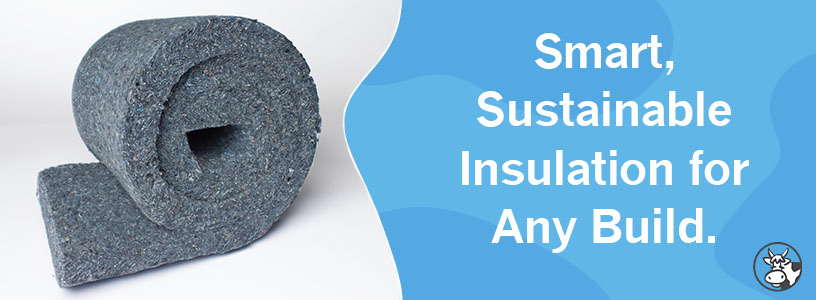
Across residential and small commercial projects, insulation needs to do more than regulate temperature—it should enhance comfort, reduce noise, and support sustainability goals. Whether you are working on a home, office, classroom, or recording studio, cotton-based insulation offers a durable, eco-conscious solution without compromising on performance.
Most standard thermal insulations are engineered for temperature control, while only a few options—typically select mineral wool products—are specifically designed with acoustic performance in mind. That is where cotton-based insulation sets itself apart. It offers a rare combination of thermal and acoustic benefits in an easy-to-handle format that is ideal for professionals and homeowners alike.
How Cotton-Based Insulation Absorbs Sound
Cotton-based insulation absorbs sound by leveraging its open-cell fiber structure and densely packed recycled material. As sound waves enter the material, they are disrupted and dissipated through internal friction—converting acoustic energy into heat and reducing echo and noise buildup inside the room.
In addition to acoustic control, the same dense structure helps slow the transfer of heat through conduction and convection. For example, Quiet Batt® Soundproofing Insulation provides an NRC (Noise Reduction Coefficient) of 0.95 at 3″ thickness, meaning it absorbs 95% of sound energy—a high-performance benchmark for residential and light commercial applications.
What Makes Cotton-Based Insulation Different?
Cotton-based insulation does not just perform — it aligns with modern building priorities like health, safety, and environmental responsibility. Here is what typically sets this insulation type apart:
- Recycled Content: Commonly made from high percentages of recycled cotton fibers, often upcycled from post-consumer textiles.
- Safe Additives: Typically treated with non-toxic borate compounds for fire, mold, and pest resistance—without introducing harmful VOCs.
- Moisture Tolerance: Naturally vapor-permeable, allowing water vapor to pass through and helping reduce the risk of trapped condensation when installed in a properly ventilated wall system.
- Thermal Performance: Provides competitive R-values for batt insulation, with performance varying by product thickness and density.
- Form Stability: Generally resists settling and maintains its shape over time when properly installed.
- Low Embodied Energy: Requires significantly less energy to manufacture compared to many foam- or mineral-based insulation materials.
- Easy Installation: Typically comes in batt form that can be cut and installed with standard tools, making it accessible for DIYers and professionals alike.


Comparing Common Insulation Types
|
Category |
Cotton-Based Insulation |
Mineral Wool |
Cellulose Insulation |
Spray Foam (Open or Closed Cell) |
|
Primary Material |
Recycled cotton fibers |
Basalt or slag |
Recycled paper fibers |
Polyurethane or similar compounds |
|
Sustainability |
~80–85% recycled content; low embodied energy |
Natural minerals; high energy input |
~75–85% recycled content; moderate energy input |
Petroleum-based; high embodied energy |
|
Health & Handling |
Comfortable to handle; no respirator needed |
Requires protective equipment |
May create dust during install; PPE recommended |
Requires ventilation and curing time; may release VOCs |
|
Acoustic Performance |
High (dense, open-cell structure) |
High (dense/heavy) |
Good; may settle over time |
Moderate (open-cell better than closed-cell for sound absorption) |
|
Installation |
Cut-and-fit; standard utility knife |
Cutting tools + PPE required |
Blower equipment or loose-fill installation |
Professional application only; expands in place |
Where Cotton-Based Insulation Performs Best
Cotton-based insulation is well suited for a wide range of applications—especially where comfort and indoor air quality matter:
- Interior Walls & Ceilings: Reduces airborne noise transfer between rooms such as bedrooms, offices, classrooms, and studios.
- Floor Assemblies: Enhances thermal comfort and acoustic dampening between levels in multi-story homes or mixed-use buildings.
- Retrofits & Remodels: Flexible batts easily fit irregular stud bays, making Quiet Batt® an ideal solution for energy upgrades or historic renovations.
- Sustainable, Low-Toxicity Projects: Preferred for green buildings, schools, healthcare facilities, or homes where non-toxic materials and indoor air quality are a priority.


Why Commercial Pros Choose Quiet Batt®
Quiet Batt® is trusted by architects, builders, and energy consultants for its performance and ease of use. Those strengths come through in several key areas, including:
- Dual-Function Performance: Provides both sound absorption and thermal insulation in one eco-friendly product.
- Efficient Installation: Easily fits into standard framing—no specialized tools or equipment required.
- Consistent Form & Fit: Resists sagging and settling, maintaining acoustic and thermal integrity over time.
- Supports Green Certification: Contributes to LEED and other sustainability frameworks through recycled content and low embodied energy.
- Jobsite Safe: Low-irritant and non-toxic—safe to handle on occupied job sites and in sensitive environments.
- Ideal for High-Performance Spaces: Frequently used within wall assemblies in offices, education facilities, recording studios, hospitality spaces, and green-certified buildings where sound control and sustainability are key.
See It in Action: Quiet Batt® also delivers impressive fire performance—check out how it behaves in a real burn test.
Quiet Performance. Smart Choice.
Cotton-based insulation offers high acoustic absorption, consistent thermal performance, and sustainability credentials. Whether you are insulating a home theater or designing a low-VOC office space, our experts can guide you toward the best approach for your project.








